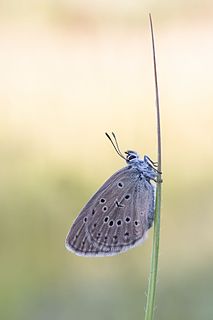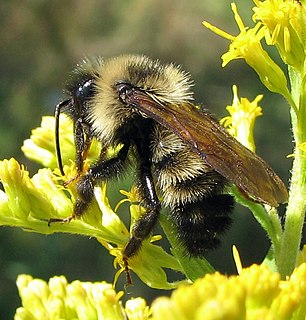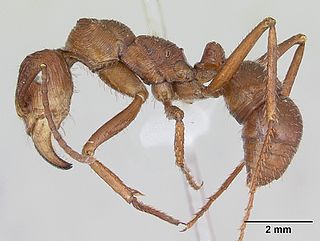
Ants are eusocial insects of the family Formicidae and, along with the related wasps and bees, belong to the order Hymenoptera. Ants evolved from vespoid wasp ancestors in the Cretaceous period, and diversified after the rise of flowering plants. More than 13,800 of an estimated total of 22,000 species have been classified. They are easily identified by their geniculate (elbowed) antennae and the distinctive node-like structure that forms their slender waists.

Parasitism is a close relationship between species, where one organism, the parasite, lives on or inside another organism, the host, causing it some harm, and is adapted structurally to this way of life. The entomologist E. O. Wilson has characterised parasites as "predators that eat prey in units of less than one". Parasites include single-celled protozoans such as the agents of malaria, sleeping sickness, and amoebic dysentery; animals such as hookworms, lice, mosquitoes, and vampire bats; fungi such as honey fungus and the agents of ringworm; and plants such as mistletoe, dodder, and the broomrapes.

Behavioral ecology, also spelled behavioural ecology, is the study of the evolutionary basis for animal behavior due to ecological pressures. Behavioral ecology emerged from ethology after Niko Tinbergen outlined four questions to address when studying animal behaviors: What are the proximate causes, ontogeny, survival value, and phylogeny of a behavior?

Tetramorium atratulum is a rare workerless socially parasitic ant from the Palaearctic region, which has even been introduced together with its host in North America. This extreme inquiline is represented only by female and pupoid type male individuals, whose morphology and anatomy indicate a highly specialized level of parasitism. The body of males is depigmentated, the cuticle is thin, the petiole and postpetiole are widely connected, and degenerate mandibles, palps, and antennae are observed. Female wing venation is reduced and the occipital region is narrowed. Mature females are typically physogastric and found in queenless host nests.

Brood parasites are animals that rely on others to raise their young. The strategy appears among birds, insects and fish. The brood parasite manipulates a host, either of the same or of another species, to raise its young as if it were its own, usually using egg mimicry, with eggs that resemble the host's.

Ant mimicry or myrmecomorphy is mimicry of ants by other organisms. Ants are abundant all over the world, and potential predators that rely on vision to identify their prey, such as birds and wasps, normally avoid them, because they are either unpalatable or aggressive. Spiders are the most common ant mimics. Additionally, some arthropods mimic ants to escape predation, while others mimic ants anatomically and behaviourally to hunt ants in aggressive mimicry. Ant mimicry has existed almost as long as ants themselves; the earliest ant mimics in the fossil record appear in the mid Cretaceous alongside the earliest ants. Indeed one of the earliest, Burmomyrma, was initially classified as an ant.

Phengaris rebeli, common name mountain Alcon blue, is a species of butterfly in the family Lycaenidae. It was first found and described in Styria, Austria, on Mount Hochschwab around 1700. Although it was initially classified as a subspecies of P. alcon, a European researcher, Lucien A. Berger, designated it as a separate species in 1946. Genetic similarities between P. rebeli and P. alcon have led many researchers to argue that the two are the same species and differences are due to intraspecific variation.
Myrmecia inquilina is a species of ant endemic to Australia in the subfamily Myrmeciinae, first discovered in 1955 and described by Athol Douglas and William Brown Jr. in 1959. These ants are large, measuring 21.4 millimetres (0.84 in). During the time of its discovery, Douglas and Brown announced M. inquilina as the first social parasite among the primitive subfamilies, and today it is one of the two known Myrmecia species to have no worker caste. Two host species are known, Myrmecia nigriceps and Myrmecia vindex. Aggression between M. inquilina and its host species does not occur, and colonies may only produce M. inquilina brood months after the inquiline queens begin to lay their eggs. Queens eat the colony brood or trophic eggs, and other Myrmecia species may kill M. inquilina queens if they reject them. Due to its restricted distribution and threats to its habitat, the ant is "vulnerable" according to the IUCN Red List.

Polyergus breviceps is a species of ant endemic to the United States. It is a social parasite of other ants, namely of Formica gnava but also of Formica occulta and Formica argentea. Polyergus is an inquiline parasite, having lost its ability to take care of its young and themselves. "The workers do not forage for food, feed the young or the queen, or even clean up their own nest". To survive, Polyergus workers raid Formica nests to steal the pupae—which, once hatched, become workers of the mixed nest. This sort of relationship is not unique, of the approximately 8,800 species of ants, at least 200 have evolved some form of symbiotic relationship with one another. What makes Polyergus special is the way a newly mated queen can, all by herself, take over a Formica nest and start a new colony.

Bombus citrinus is a species of bumblebee known commonly as the lemon cuckoo bumblebee due to its lemon-yellow color. It is native to eastern North America.

Dolichovespula adulterina is a species of parasitic social wasp found in the Palearctic region. D. adulterina feeds on a variety of foods, including insects, spiders, arthropods, meat, molluscs, fruit, nectar, and larval secretions. D. adulterina was formerly considered to be synonymous with D. arctica from the Holarctic region, but more recent research indicates that D. arctica is a separate species.

Temnothorax is a genus of ants in the subfamily Myrmicinae. It contains more than 380 species.

Ectatomma is a Neotropical genus of ants in the subfamily Ectatomminae. The genus contains 17 described extant species and one extinct species.

Gnamptogenys triangularis is a Neotropical species of ants in the subfamily Ectatomminae. Native to the forests of South and Central America, G. triangularis is a predatory ant that feeds on millipedes. In its native range, this species is known from Buenos Aires, Argentina in the south to Costa Rica in the north, with records from eight countries in South America, and two countries of Central America. The first records of G. triangularis outside its native range came from Florida beginning in 1985 and Alabama in 1996.

Ectatomma ruidum is a Neotropical species of ant in the subfamily Ectatomminae.

Slave-making ants are brood parasites that capture broods of other ant species to increase the worker force of their colony. After emerging in the slave-maker nest, slave workers work as if they were in their own colony, while parasite workers only concentrate on replenishing the labor force from neighboring host nests, a process called slave raiding.
Mycocepurus castrator is a species of parasitic ant, in the genus Mycocepurus, native to Brazil. Described in 2010, the species is a workerless and obligate parasite of the related ant Mycocepurus goeldii. It is known only from Rio Claro, Brazil, and has only been found in nests of M. goeldii.

Ectatomma tuberculatum is a Neotropical species of ant in the subfamily Ectatomminae. Common in the Neotropics, the species is found from Mexico to Argentina. It is a host to the related social parasite Ectatomma parasiticum, the only known parasitic species in the subfamily Ectatomminae.

Symphiles are insects which live as welcome guests in the nest of a social insect by which they are fed and guarded. The relationship between the symphile and host may be symbiotic, inquiline or parasitic.

Vespula infernalis is an obligate parasitic wasp, parasitizing the nests of other species in the genus Vespula. Its common host species is V. acadica in North America. It is sometimes called the cuckoo yellowjacket wasp due to its inquiline lifestyle. They differ from other parasitic wasps in their intensely aggressive behaviour during invasion and occupation of the host colony. Several morphological adaptations such as bigger body parts and more curved sting shafts are observed in these wasps to aid their aggressive parasitic behaviour. Once they occupy a host's nest, V. infernalis are known to engage in mauling and chasing of host workers and forced trophallaxis. Female wasps will also force host workers to feed and take care of their brood.

















